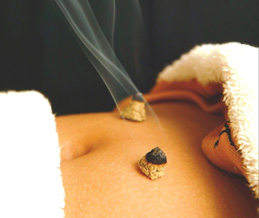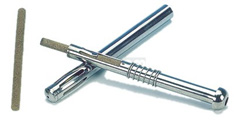
We often come across clients who have had an old injury which they sustained when they were young, that is now starting to play up and cause them pain. These are injuries that have never fully healed, and have remained as a weak area in their body. The injury starts to cause pain or stiffness over time as muscular tension increases in the area, or the location gradually becomes even weaker.
A weakness will often develop in any part of the body that has been damaged, abused or overused. For example, someone who constantly uses their eyes staring at a computer screen may find that their eyesight starts to deteriorate over time. Or a person who drank heavily when they were young will be more prone to liver problems when they get older.
Moxa is often very effective in treating these old weakened or damaged areas. It increases the blood flow into the damaged area, and stimulates the body’s healing and repair processes. It can be used to treat a damaged area that has started to play up, or even to prevent problems developing in the future.
Moxa can also be used to treat people who are scared of the idea of having acupuncture treatments.
Moxa is made by drying, crushing and sifting the leaves of a special herb (Artemisia argyi). The use of moxa is an important part of any acupuncture training, and we use it in most acupuncture treatments we perform at our clinic.
It is said that acupuncture moves, changes and shifts things in the body, and that moxa warms, strengthens and boosts the body. Moxa
Because it addresses the weakness in the area, moxa may produce a more permanent improvement in the problem than acupuncture, which is why we often use both in a treatment.
Research conducted in Japan[1] shows that moxa
There are said to be over 50 methods of using moxa, but the main techniques we use are:

Tiger Warmer
It is important to realise that the warmth from moxa has a completely different effect on the body to other types of heat. There has been plenty of research into how moxa produces its effects on the body, and many theories have been put forward, but there are no clear answers yet. Originally it was thought that the essential oils in the plant may have produced the benefits, but now it is believed that the unusual frequency of the far infra-red heat produced by the smouldering moxa causes the changes.
For rice-grain moxa, we only use the highest grade from carefully selected, superior quality plants gathered from the Ibuki Mountain in Japan during midwinter. This moxa consists of the hairs from the leaves of the plants, and is so pure that virtually no smoke is produced when it burns. This grade is known as ‘Gold moxa’ due to its colour (and possibly its scarcity and price!).
For cone and warm-needle treatments, we use Extra Pure Wakakusa Grade moxa, a very high quality moxa from the leaves of the plant.
Moxa has been used as part of acupuncture treatments for around 3,000 years, and some people believe that it was even used to treat people before acupuncture was developed. In Japan, it is traditional for a child to receive a moxa treatment from the head-man of their village whenever they have a birthday, to ensure good health for them. And in China, the soldiers used to carry moxa kits, so that when they couldn’t march any further, they would moxa a point on themselves so they could keep marching.
After World War II, the Americans occupied Japan, and banned the use of acupuncture and moxa, believing them to be barbaric and primitive practices. They had no idea how much opposition they would encounter! Traditional practitioners banded together and mounted a massive campaign, enlisting the help of doctors and scientists who understood the value of these practices. After a long legal battle, the therapists prevailed, and so these practices survived.[2]
In Japan, moxabustion (treatment by burning moxa) is considered a therapy in its own right, and there is separate registration for acupuncturists and moxabustionists. However, most acupuncturists incorporate some degree of moxa treatments in their practice. It is common in Japan for acupuncturists and moxabustionists to teach their clients how to perform simple moxa treatments on themselves at home for their condition, and platform or ‘stick-on’ moxa is commonly sold in various shops as a form of self-treatment. The person sticks the small cylinder of moxa on the painful spot, lights it, and removes it when the right level of warmth is felt.
It sounds like moxa can be used for almost anything, but obviously some conditions respond better than others to it. Usually the longer the problem has been there, the more important it is to use moxa, and the more inflammation there is, the less moxa should be used on the inflamed area.
It is particularly important to use it for any conditions involving the blood (including period problems and fertility), the nervous system, and the immune system. Moxa is very gentle and safe, and can be used on acupuncture points that can’t be needled during pregnancy.
So if you notice a light smoky smell when you come to the clinic, you know that someone has just had their body boosted and strengthened!
For more information about moxa and how it may be able to help you, please talk to Peter or one of our other acupuncturists.
[1] Japanese Acupuncture and Moxibustion Skills Foundation Newsletter, Vol. 1, Issues 3 & 4
[2] Practical Moxibustion Therapy, by Junji Mizutani, R.Ac., 1998

Valued at $120, your Assessment will help to uncover:
All this will be fully explained to you, and you can ask as many questions as you like. That way we can be sure to give you all of the right information, understanding and advice you need. Terms and conditions: This is a free, no obligation offer.